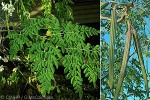Cook Islands Biodiversity Database
Species Page
Moringa oleifera
Drumstick Tree
Multimedia & Additional Resources
| Type | Description | Download |
| Fleaves, flowers and fruit | 95KB |
General Information
Cook Islands Distribution
| Southern Group: Present Makatea: | ||||||||
RR |
MG |
AT |
MK |
MT |
AK |
PL |
TK |
MN |
| Northern Group: | |||||
TN |
MH |
RK |
PK |
NS |
SW |
+ |
- |
||||
Scientific Taxonomy
Moringa oleifera Lam.
SYNONYMS: Moringa pterygosperma
TAXONOMY: PLANTAE; ANTHOPHYTA (=Angiospermae); MAGNOLIOPSIDA (=Dicotyledones); DILLENIIDAE; Capparales; MORINGACEAE
More Information
GENERAL NOTE: A very useful ornamental tree. Flowers, young leaves and immature fruit edible as a vegetable; and the crushed root gives a horseradish-flavoured seasoning. Used medicinally in India. Ben Oil, the oil extracted from the seeds can be used in salads, soap, perfumes and to oil machinery. A nutritious tree: leaves contain high amounts of vitamin A (four times more than carrots), vitamin C (seven times more than oranges), protein (5-10%), calcium (four times more than milk) and potassium (three times more than bananas). The young seed pods and seeds (which taste like asparagus), and flowers (which taste like mushrooms) are edible. The seed is often used purify dirty or cloudy drinking water. It is pounded into small fragments, wrapped in a cloth, and then placed into water jars or containers. The pounded seed acts as a flocculent, taking impurities out of the water solution. In the Nile Valley, the name of the tree is "Shagara al Rauwaq" which means "tree for purifying". Moringa seed contains about 35% oil. Sweet and non-sticking, this oil is often extracted for cooking and in rare cases--even lubrication purposes. It does not turn rancid, is excellent in salads, can be used for soap making, and burns without smoke. One Indian tradition says the leaves can prevent more than 300 illnesses!!!!!
Vouchers & References
Vouchers:
None Recorded.
References:
p.373 Neal - In Gardens of Hawaii
p.742 Hortus 3rd
p.759 Royal Hort. Soc. Index of Garden Plants
p.662 Tropica
p.2/712 A.C.Smith - Flora Vitiensis Nova
Data Update History (information):
zTX, zB02, zM04b, zD02, zupD04a
Web Resources
Citation Information
McCormack, Gerald (2007) Cook Islands Biodiversity Database, Version 2007.2. Cook Islands Natural Heritage Trust, Rarotonga. Online at http://cookislands.bishopmuseum.org. ![]()
Please refer to our use policy.

